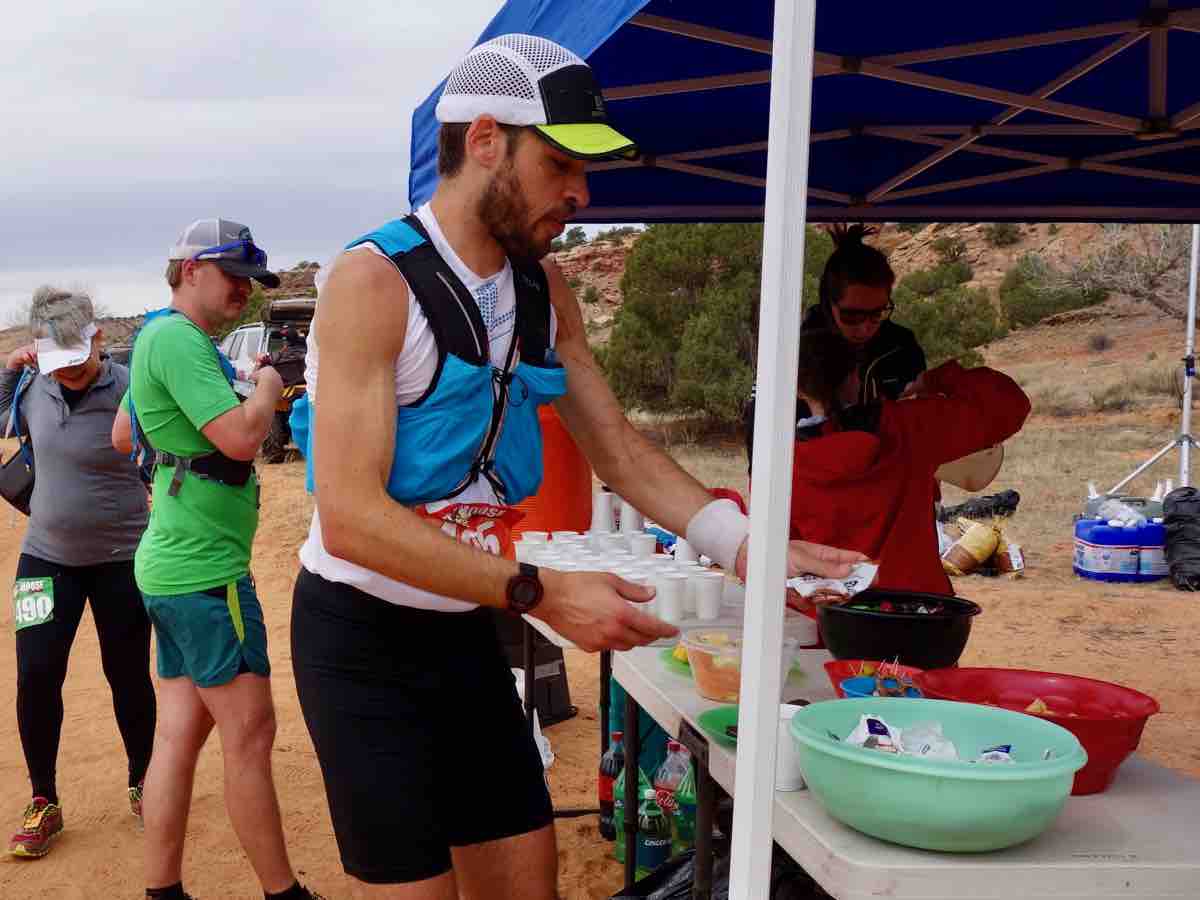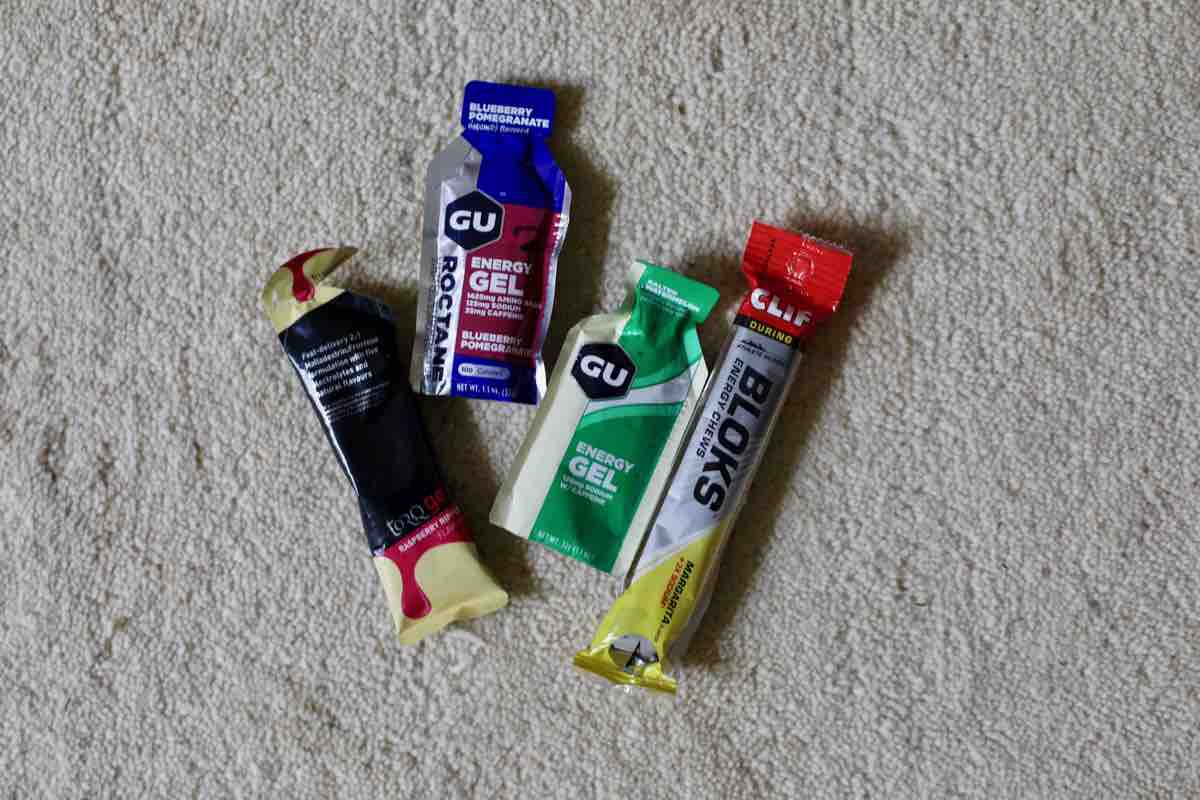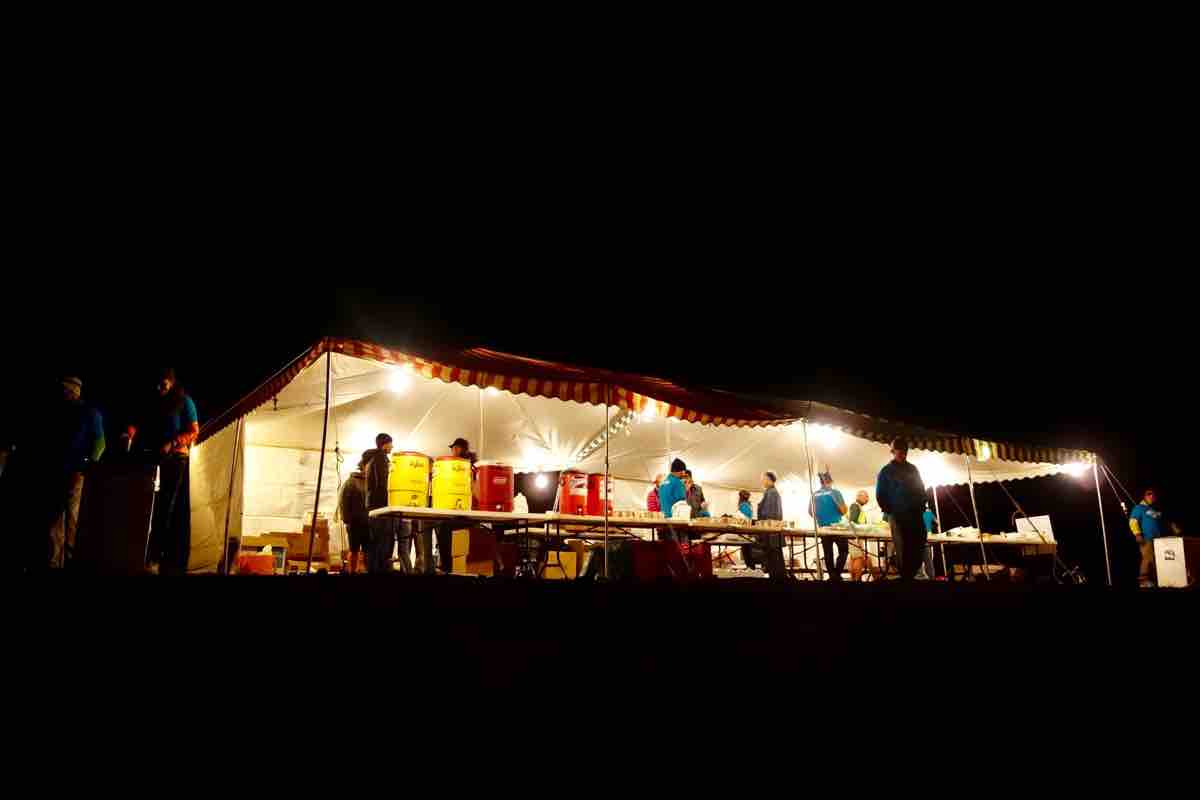I remember the first time I took someone else’s advice about eating on the run. I was preparing to run my first 50k and I was scared about my lack of a nutrition plan. I had done a lot of long-run training and never experienced the ‘wall’ that so many runners talk about. A very experienced ultrarunning coworker scared me right into following his nutrition plan for my 50k. I ended up running a strong first half but shortly after experienced the discomfort and performance decline from a distended stomach and puke spewing out of me during the second half of the race. I should have known better than to change things so drastically on race day and to instead stick to what had been working for me, but like so many beginners to the sport, I trusted that someone more experienced knew more about what was good for me than I knew.
If you are like I once was and feeling overwhelmed by all the options and choices of what to eat and how often to eat it when you are running, this article will introduce you to the basics of taking in calories via carbohydrates while running, a fairly simple way of maintaining good energy and a content digestive tract. The information in this article is designed for anyone tackling runs of two to four hours at an effort that will leave you tired afterward. Beyond four-hour runs or for very easy long runs, your nutritional needs will likely change. Just remember, though, that there is no one-size-fits-all standard for endurance-running nutrition. We are all unique in our nutrition needs during long runs and races, and you practicing will hopefully make perfect for you. So, what I’m saying is, take the information from this article, do your own experiments, learn and read more, and find out what does and doesn’t work for you.
The body uses its stored carbohydrates as well as some of its stored fat to fuel running. (The body also uses its stored protein to fuel running, but we won’t detail this in this article.) The ratio of stored carbohydrates and fats you can burn while running depends on a number of factors, most importantly your effort. No matter what speed you run, there is a limited supply of accessible carbohydrates in the body that can be used to fuel running, what amounts to about 90 minutes of running a decent effort for most people. Beyond that and if you don’t feed yourself more carbohydrates, the body must use predominantly stored fat as fuel. This requires either a rigorous adaptation process in order to run at similar paces (that will not be discussed in the balance of this article because of its complexity) or for those not adapted to fat utilization during running, a big slowdown in pace. Slowing down isn’t ideal, so ingesting more carbohydrates for the body to convert to fuel will help you maintain pace and feel energetic. In doing this, your body will continue to burn the carbohydrates you’re fueling with and some stored fat as fuel as you continue to run.
In short, if your run is 90 minutes or shorter, you will be able to replenish your nutritional needs after the run. However, if you are running longer than that at a meaningful effort, plan to intake some calories while running.
The average runner’s stomach can effectively digest a maximum of 150 to 300 calories per hour of certain types of carbohydrates, and this is dependent upon your effort, your body mass, the type of carbohydrate, the climate, and more. The average runner will burn somewhere between 600 to 1,000 calories an hour. This measurement also varies widely due to factors such as your pace, your body mass, the terrain, and more. This works out to a caloric deficit on long runs and that’s alright. The stomach cannot digest an equitable amount of calories to what you are burning.
The goal in this case, however, is to provide it with just enough calories via carbohydrates to help you perform your best. You might hear some runners talk about walking into aid stations and using them as an all-you-can-eat buffet. Indeed, it can be fun and delicious to eat on the run! But putting in more calories than you can digest or the kinds of calories that are hard to digest can make running uncomfortable or disastrous—like my first 50k! You will want to start ingesting these calories no later than 45 minutes into your run and continue to fuel with about 100 calories at regular intervals of around 20 to 30 minutes.
Maltodextrin and fructose are the types of carbohydrates you should aim to fuel with as you are getting started with using carbohydrates as running fuel. Consuming both types of carbohydrate at the same time allows your stomach to absorb more carbohydrates than consuming a single form. When you are reading the ingredient list on your endurance-running nutrition product labels, look for both types of carbohydrate. Some runners have success by consuming small amounts of other kinds of carbohydrates on longer runs (like ones in the four-hour-plus range), too.
As you start your experimentation, keep a food log as part of your training log. Track the amounts and ratios of maltodextrin, fructose, and any other kinds of carbohydrates you ingest during a long run. Many runners will feel better on one form of carbohydrate or the other and sometimes a single brand or flavor will cause indigestion and discomfort. Looking back on your training log for those patterns can significantly reduce the amount of time you spend feeling uncomfortable or changing your long-run plans due to stomach issues. It might help to note how you felt during the run—digestively and energetically—as well as what the weather conditions were like.
Some runners feel better when they also consume a bit of protein—via amino acids—while running, especially during and after long runs. Many endurance-running nutrition products contain amino acids. Be sure to track this in your food log, too, to see how it makes you feel.
Ingesting fat is recommended only if the athlete is running at a very low intensity (unless, as mentioned, the athlete has adapted to the process of using fat for running at higher speeds, which this article doesn’t address), and this is not likely during runs shorter than four hours. Most endurance-running nutrition products do not contain fat.
There are several kinds of substances that you can eat and drink to ingest calories while on the run:
Gels and Gummies/Chews
These are the most common delivery methods for calories. These single-serve packets contain a gel-like substance or very-easy-to-chew blocks. Generally, you take the gels in two or three swallows and the chews require mild chewing before swallowing. Each packet contains about 100 calories (although that can vary, so check the label) so you would want to plan to take 1.5 to three packets for every hour you are running. These products may also boast about the extras they contain such as electrolytes, caffeine, and amino acids.
Solids Like Bars and Waffles
On basic premise, these are solids that contain more than maltodextrin and fructose. What is added can run the gamut from other simple carbohydrates, to complex carbohydrates, to fats, to protein, and more. These are more appealing to me the longer I am out. Taking eight gels can feel monotonous and eating something chewable intermittently gives my brain a little boost. Do use care with what is in the product and begin with the simplest ingredient lists first. Like with gels and gummies, you will find some of these also contain extras like electrolytes, caffeine, and amino acids.
Powders
Many brands produce a powdered form of energy that is designed to be added to your water. Follow the mixing instructions on the product label, as each product’s serving size is made to match the number of calories average runners can absorb per unit of liquid. With experience, you may be able to dilute or concentrate your solution of powder to water based upon how much you drink, your exertion levels, the weather, and more.
You should know that relying solely on enhanced water for your nutrition has pros and cons. On the plus side, ingesting calories every time you drink can give you a steady stream of calories without having to carry anything extra or make any extra effort. If you are ingesting a more solid form of calories like gel or a bar, you can supplement with liquids containing calories and get even more calories without extra effort. On the down side, you may not drink enough in an hour to ingest enough calories and would definitely need to supplement with solids. Additionally, sometimes it is nice to drink just plain water. With all the flavors and sweetness in gels, bars, and other endurance-running nutrition products, drinking something with more flavor can become a challenge, which would then affect your performance due to dehydration. Bottom line, if you plan to add calories to your water, plan to have supplemental fuel as well as plain water with you in addition until you know if this kind of calorie intake works for you.
Real Food
Yes, it’s possible to eat real food while running. I know people who eat dehydrated berries, smashed berries, peanut butter and jelly sandwiches, bananas, potatoes, sweet potatoes, rice cakes, and a variety of other real food while running. The plus side is that you get to eat real food! The down side is that it can be bulky to carry plus you will generally ingest some amount of fiber. As you may have experienced, running has a way of shaking your digestive system clean. Fiber can have a way of enhancing that effect, which is why most endurance-running nutrition products don’t contain the ingredient. If you opt for real food, do your research to know how many calories you are ingesting and be sure to know exactly how it makes your bowels move prior to race day. Also, real food can be a challenge to digest when running in certain conditions, like in heat or at significant effort. In other words, for several reasons, use caution when eating real food on runs of two to four hours.
Now it’s time to head to your local running store to look at the shelves of colorful labels and shiny packages! Start small with a few flavors and few brands. If you find something you like, stick with it while experimenting with other products to see if there is something that works even better. You got this!

Chris Mocko grabbing some gels from an aid station at the 2017 Behind the Rocks 50 Mile. Photo: iRunFar/Meghan Hicks
The basics of running nutrition can be daunting, so here are the key takeaways of this article for consuming carbohydrates on runs lasting two to four hours:
- Plan to take in calories if you are planning to run longer than 90 minutes at a meaningful-to-you effort.
- Try to ingest 150 to 300 calories an hour for any runs lasting longer than one hour. Avoid consuming more than 300 calories, as your body may not be able to digest what you are eating as fast as you are eating it. Basically, aim to eat what helps you feel energetically strong and digestively at peace.
- Add protein–via products containing amino acids–if it makes you feel better.
- Don’t add fat to your diet while actually running unless you’re adapted to it.
- Pick your poison of gels, chews, solids, powders, or other options. There are a lot of ways to get these calories, so find the one that works best for you.
- Track your caloric intake–both in terms of what you are eating and the rate at which you are eating it–in your training log so you can easily look back to find what worked and what didn’t work. Also note how what you’re eating makes you feel.
Finally, as we mentioned at the beginning of the article, don’t be talked out of what you know works for you. Every person is different, which is exactly why there are so many products and so much information about running nutrition out there. With all the variety, you will find something that works–even if it is a bar made out of cricket flour. Once you find that secret sauce, don’t let someone else tell you that you are wrong for using it. Their body may work slightly differently from yours.
It’s certainly good to experiment with different fuels and ways of fueling if you are having trouble with energy and digestion while running, but try not to do so on critical runs and at races. Experiment on a day when an extra loo stop or energy lull isn’t going to ruin your outing. In races and during critical long runs, stick to what you know works for you and enjoy the benefits of staying fueled while running!
Call for Comments (from Meghan)
- For those with some experience in fueling while running, can you share an example of what you ate and how you ate it during a long run or race when you got your nutrition ‘right?’
- And, how about a story from when you running nutrition was ‘wrong?’ Specifically what did you eat, how much did you eat, and what problems resulted?
- If you are just getting started with fueling on trail runs, what specific questions and needs do you have? Leave a comment to start a discussion.



